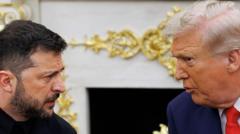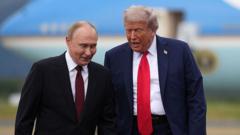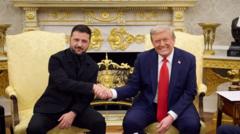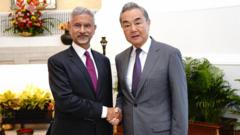During discussions with President Zelensky, contrasting views emerged regarding Ukraine's territorial integrity amid ongoing conflict with Russia.
**Map in Oval Office Signals Tensions Over Ukraine's Fate in Trump-Zelensky Talks**
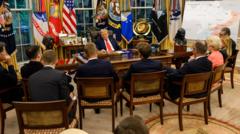
**Map in Oval Office Signals Tensions Over Ukraine's Fate in Trump-Zelensky Talks**
The Oval Office map highlights the extent of Russian occupation in Ukraine, shaping President Trump's perspective on potential territorial compromises.
A significant map positioned in the Oval Office has drawn attention to the Kremlin's territorial claims in Ukraine, visibly showcasing a portion of the country shaded in red, marking the areas currently under Russian occupation. This visual aid became crucial in framing President Donald Trump's dialogue with Ukrainian President Volodymyr Zelensky during their recent meeting. Commenting on the map, Trump asserted, “A big chunk of territory is taken,” signaling a pointed message from the White House regarding the realities on the ground.
Zelensky's mission was to present a counter-narrative, bringing his own map to emphasize the dynamic nature of control in Ukraine. According to Zelensky, he had been "fighting with what is on that map" during his talk with Trump, underscoring the importance of accurately representing the on-ground situation instead of relying on assumptions. Trump maintained that Russian forces appeared significantly stronger and had not shown signs of retreat.
The White House map depicted Russian dominance in regions such as Donetsk and Luhansk, with Zelensky arguing over these statistics, illustrating the stark reality that 79% of the Donbas area is currently under Russian control. Previous to the conflict escalating in 2014, this resource-rich region contributed notably to Ukraine's economy, accounting for approximately 16% of its output.
As discussions unfolded, it became evident that different methodologies in measuring territorial control might lead to discrepancies between American and Ukrainian assessments. For instance, areas that the U.S. believes are minimally occupied by Russian troops may actually be circumstances of sporadic occupation or contested presence. Despite the advances made by Russian forces in recent months, analysts estimate it could take years for Russian troops to fully secure control over the remainder of the contested Donetsk region.
As both leaders navigated their positions, Zelensky expressed skepticism, presenting a Ukrainian map that indicated only minimal gains by Russia over the past 1,000 days of conflict. Despite claims to territorial advances, it remained clear that the front lines have seen little significant movement since the war began, as Russian aggression continues to face staunch Ukrainian resistance.
Analysts noted that while Russia's military has reportedly bolstered its numbers, the overall strategic balance remains complex. An attempted Russian advance near Dobropillya was successfully countered by Ukrainian forces, reaffirming Ukraine's control over significant territories in the Donbas region.
With the ongoing tension over control and territorial integrity, this dialogue between Trump and Zelensky encapsulated the broader geopolitical implications of the conflict, particularly as they assessed the potential for future negotiations on critical issues like land swaps and territorial compromises amidst the backdrop of war. Each leader's differing interpretations of maps serve as a testament to the intricate complexities of sovereignty and control in modern warfare.

